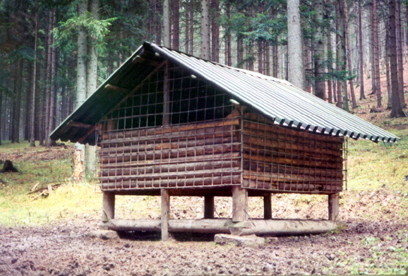

Hunters
Among those most at risk of being attacked by a bear undoubtedly belong hunters. Moving quietly through forested terrain, mostly alone or in pairs, increases the risk of sudden close encounters. The closer you are to a bear at the moment when it notices you, the greater is the risk that it will react by attacking in self-defence.
Defensive behaviour by bears is almost always the result of you entering its personal space, surprising it or getting too close. An injured (shot) bear and a female with cubs are particularly dangerous. Occasionally a bear that does not know you are there may approach and be surprised. Sometimes a bear startled by a group hunt (for wild boar, for example) may flee from some hunt participants but run into another person.
If a bear feels threatened and has no escape route it may attack in self-defence. This most often happens during an encounter with a bear at a distance of less than 20 metres. An attack can be very sudden, so carrying a gun should not give a false sense of security: you may not be able to react in time. If you cannot see well in front and around you to a distance of at least 50 metres, for example in dense vegetation, increase your vigilance. Be very careful around carcasses. When collecting cast antlers, be cautious in obscure or rocky terrain, where you might chance upon a bear den.

Ungulate feeding sites can also attract bears if maize, cereals or fruit are used. The same is so of baits for foxes. Care should therefore be taken so that such "attractants" are not near public footpaths, cottages and the like, where they could present a danger to the public.
If you shout at a bear that was not aware of you, you could provoke an attack. It is better to make a wide detour around it or go back the way you came. If it has already noticed you, stand still and quickly assess the situation. If the bear is not moving towards you, carefully try to increase your distance from the bear while still watching it. When you move away, most bears will calm down. Do not run: this could lead to pursuit. During a sudden encounter at close range, avoid looking into a bear's eyes (for animals this is a sign of aggression).
It may be surprising, but independent tests have found that when a bear attacks, pepper spray ("Bear spray") is more reliable than firearms. Using the spray creates a protective cloud between the person and the bear, which is more likely than a bullet to contact the bear.
If you are physically attacked and it is a defensive attack, lie on your belly, legs slightly apart, your hands joined behind your head, and play dead. This position will protect your face and neck; when the bear senses that you are no longer a threat it will usually leave. If you fight back against a bear or try to reach a gun or escape, there is a risk that you will provoke a more intensive, longer or repeated attack, during which you could be more seriously injured.
We recommend watching the excellent film "Staying Safe in Bear Country". It not only contains useful advice but also wonderful footage and a wealth of information about bears.



